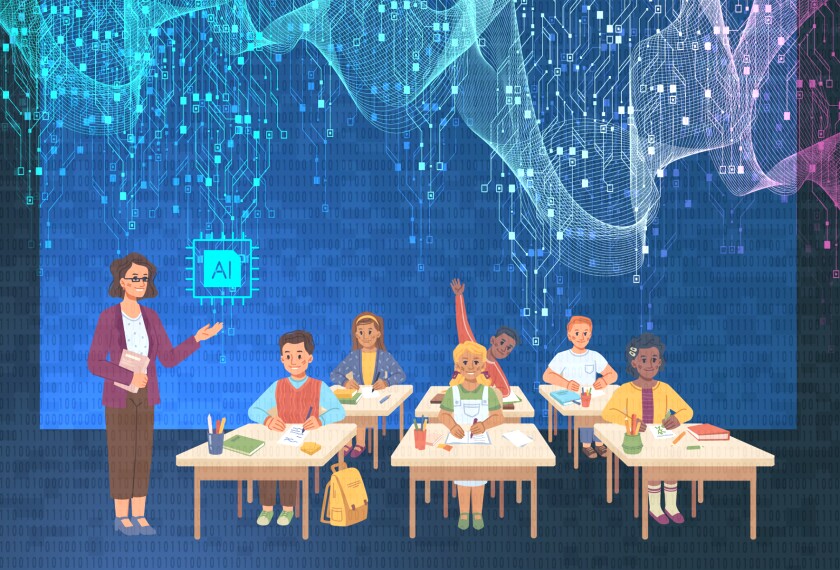With technological breakthroughs in generative AI happening at unparalleled speed, it’s useful to remember the social nature of education and the consequent importance of teachers.
The free exchange of ideas through small-group work, the laughter that takes place naturally in the classroom, the curious eyes, and the raised hands—all reflect human learning. When the social elements are missing or compromised, as they were during COVID-19 school building closures, it is challenging for schools to help students engage and learn.
Both research and experience tell us that in most times and places, education has been a social and interpersonal process. And teachers are the most fundamental element of that process. To put it simply, teachers are irreplaceable, even in the age of wondrous chatbots.
So rather than forcing one more digital tool into teachers’ already busy schedules, what if we harness the power of AI to support them and simultaneously honor their central position in education?
At a time when teachers are being burnt out, new AI tools need to help teachers free up their time and foster meaningful relationships with students. To that end, one area where AI has tremendous potential is teacher professional development. While teachers today receive many different forms of feedback on their instruction, not all feedback is equally useful. In particular, suggests that teachers appreciate and need feedback that is nonthreatening, timely, and trustworthy.
Different from evaluative feedback, this kind of feedback aims to modify teachers’ thinking or behavior to improve their teaching. For example, do teachers ask open-ended questions that elicit students’ higher-order thinking? Do teachers effectively engage students from all backgrounds and not just some? Teachers need feedback opportunities on these and other topics to reflect upon their strengths as well as areas needing improvement.
Providing teachers with high-quality formative feedback is not easy, however. Training raters and paying them to visit classrooms is extremely time consuming and resource-intensive. In practice, principals, who are already time-strapped, often have to step in and do classroom walk-throughs. But principals tend to be in commenting on a teacher’s instruction, failing to provide the necessary information for teachers to make meaningful improvement.
The feedback could range from something simple like student-teacher talk ratio to complex teaching strategies like how often the teacher takes up student ideas.
These factors all perpetuate the status quo. On average, teachers in U.S. public schools receive feedback from their coaches and principals only once or twice a year, a frequency too low to support teachers’ professional growth.
Imagine a world where we could harness the power of AI to provide teachers with automated, valuable feedback. A teacher finishing a lesson would upload an audio recording to secured cloud storage. An AI algorithm would quickly analyze the audio and give teachers insights into their teaching. The feedback could range from something simple like student-teacher talk ratio to complex teaching strategies like how often the teacher takes up student ideas. Teachers can choose how often they want this feedback to allow for immediate adjustment and continual improvement.
This brand-new feedback loop is what our team, a group of scholars with expertise in education, linguistics, economics, and computer science, envisioned when we designed our AI-powered feedback tool. We call this tool M-Powering Teachers (M stands for machine).
As the name suggests, M-Powering Teachers leverages natural-language processing, a branch of AI that uses computers to interpret human language and can analyze the verbal aspect of classroom instruction and then deliver formative feedback to teachers. Because the entire process requires little human input, it has the potential to significantly reduce costs and increase the frequency of feedback cycles.
A common issue for many technology-based tools is that there is to show their claimed benefits. This is not the case for M-Powering Teachers. During the past two years, we tested the effectiveness of M-Powering Teachers in two distinct online teaching settings using randomized-controlled trials, the gold standard for testing cause-and-effect relationships. To make it possible to compare the findings, we focused on delivering feedback on one particular teaching practice in both studies—teachers’ uptake of student ideas. We find remarkably consistent results across the two studies.
In an online computer science course offered by Stanford University, instructors who were induced by an email reminder to interact with the feedback improved their frequency of taking up student ideas by compared with the control group. Similarly, in an online, one-on-one tutoring program that aims to improve high school students’ research skills, tutors who were offered automated feedback improved their uptake of student contributions by compared with the rest of the tutors who didn’t have access to the feedback. Our analyses also suggest that students taught by instructors or tutors who accessed the feedback more frequently had more favorable perceptions of their learning experience in both contexts compared with instructors or tutors who had no or less engagement with the feedback.
While college online courses and one-on-one tutoring are certainly different from K-12 classrooms, these two studies serve as proof of concept for automated feedback and highlight the promise of our approach. In partnership with TeachFX, our team has just finished a third study with 100 mathematics teachers in Utah to evaluate to what extent the findings of the above two studies might generalize to K-12 teachers.
In the M-Powering Teachers approach, teachers are more in control of their own professional development. They can receive on-demand, targeted feedback after each class they teach. They can use such feedback to identify areas for improvement and monitor their own progress. Principals and coaches can then focus their efforts on helping teachers make sense of the information provided and identifying strategies for improvement.
As we move toward a future where AI will have a powerful impact on teaching and learning, let’s not forget education’s interpersonal nature. AI, when used well, would not replace teachers but rather empower them to build stronger relationships with their students. As we now know, those stronger relationships are likely to translate into better classroom experiences and improved learning.






